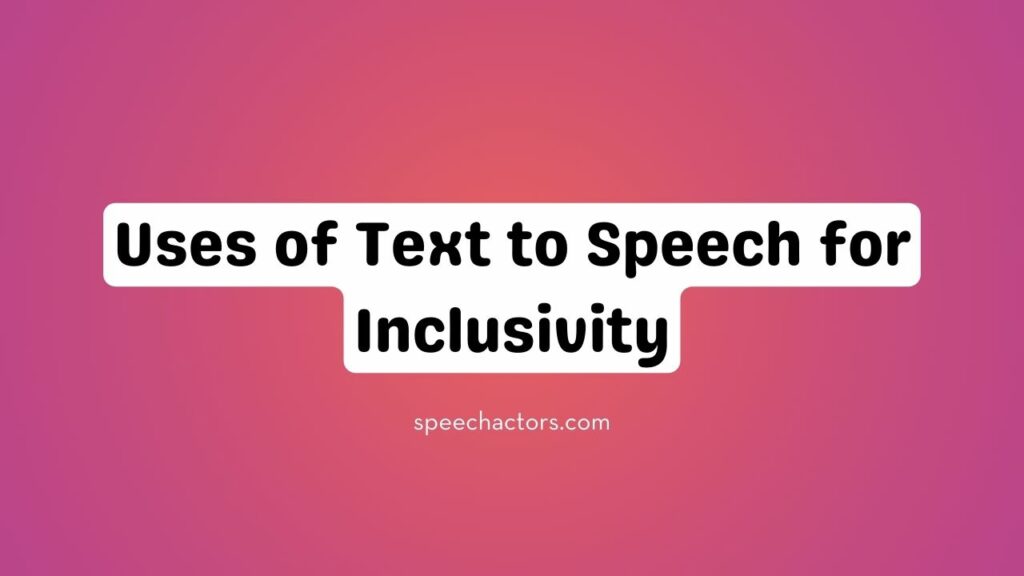Text-to-Speech (TTS) technology converts written text into natural, spoken words, making digital content accessible in a new and engaging way. In today’s global landscape, multilingual accessibility plays a crucial role in reaching diverse audiences and ensuring everyone can interact with content seamlessly.
TTS empowers users across languages by providing clear, audible versions of text, supporting learning, communication, and inclusion. By bridging language barriers, TTS enhances digital experiences for multilingual communities, creating an environment where information is easily understood, widely accessible, and inclusive for all users.
How TTS Promotes Inclusivity
Text-to-Speech (TTS) promotes inclusivity by turning written text into spoken words, making learning accessible for everyone. For learners with visual impairments, TTS provides instant access to books, notes, and digital content without the need for Braille or physical assistance.
For individuals with dyslexia or other reading difficulties, TTS helps them follow along smoothly, reducing frustration and improving comprehension. Additionally, ESL learners benefit as TTS improves pronunciation and listening skills, making it easier to grasp new vocabulary.
It also supports neurodiverse students by offering an alternative learning method that matches their unique needs. TTS ensures equal participation for all learners in educational and professional spaces.
Implementing TTS for Inclusive Learning and Content
Implementing TTS for Inclusive Learning and Content means transforming digital education into something everyone can access and enjoy. TTS can convert written materials like books, articles, and notes into clear audio, making learning easier for all.
It can also add narration to videos, presentations, and online courses, keeping learners more engaged. Personalization allows users to adjust voices, speeds, and tones, creating comfort for different learning styles.
When integrated with digital platforms and Learning Management Systems (LMS), TTS ensures smooth access for students and professionals. This inclusive approach supports diverse needs while making knowledge delivery more dynamic, flexible, and user-friendly.
Benefits of TTS for Inclusive Education
Enhancing comprehension and retention: TTS supports better understanding by combining visual text with spoken words, which helps students process and remember information more effectively.
Improving engagement and motivation: TTS keeps learners attentive by adding an interactive audio layer to lessons, making study sessions more dynamic and enjoyable.
Reducing barriers to learning for all students: TTS ensures that students with disabilities, language challenges, or different learning styles can access the same educational materials without obstacles.
Fostering equal opportunities in digital learning: TTS provides inclusive access to online courses, e-books, and study platforms, creating fair learning conditions for every student.
Best Practices for Educators and Content Creators
Best practices for educators and content creators focus on making content clear, accessible, and engaging for every learner. Choosing high-quality TTS tools such as Speechactors ensures natural, expressive voices that keep audiences connected.
Structuring content into short sentences, clear headings, and smooth pacing creates an easy listening flow. Furthermore, combining TTS with captions and transcripts supports learners who prefer to read along or need text for accessibility.
Regularly gathering user feedback helps refine delivery and ensures content works well across diverse needs. These practices make learning materials inclusive and enhance the overall audio experience for all users.
Why Speechactors is Ideal for Inclusive TTS Solutions

Speechactors is ideal for inclusive TTS solutions because it combines advanced technology with accessibility. It offers support for multiple languages and diverse voice options, making content accessible for global learners.
The platform integrates easily with educational systems, allowing schools and institutions to bring TTS into classrooms without complexity. Its realistic, human-like voices create a natural listening experience that keeps learners engaged and connected.
Educators and users often highlight how Speechactors improves learning outcomes, with testimonials showing its impact in supporting students with different needs. This mix of inclusivity, easy use, and high-quality voice delivery makes it a trusted solution for education and beyond.
Future of TTS in Promoting Inclusivity
Text to Speech is shaping an inclusive future by turning written content into natural, expressive audio for everyone. Modern AI models learn prosody, emotion, and accents, so voices sound human-like and clear.
Neural TTS adapts pace, emphasis, and context, improving comprehension for diverse users. In companies, it supports training, compliance, and multilingual updates. In schools, it helps learners with dyslexia, visual impairments, and language gaps.
In public services, it powers announcements, kiosks, and emergency alerts. Looking ahead, TTS will personalize voice identity, auto-localize content at scale, and integrate with wearables, cars, and smart cities. This creates accessible, multilingual, and user-first digital ecosystems.
Frequently Asked Questions (FAQs)
How does TTS support learners with disabilities?
TTS reads text aloud clearly, helping learners with visual impairments or reading difficulties follow lessons. Research shows audio support improves comprehension and confidence in learning.
Can TTS help ESL learners understand content better?
TTS speaks content naturally, letting ESL learners hear correct pronunciation and rhythm. Studies show listening while reading boosts language understanding by up to 40%.
What makes Speechactors’ voices suitable for inclusivity?
Speechactors offers natural, diverse voices that feel human, supporting all learners. Its clarity, tone, and expressiveness make lessons accessible and engaging for everyone.
How easy is it to integrate Speechactors into LMS or e-learning platforms?
Speechactors integrates seamlessly with most LMS systems using API tools. Educators can convert text to speech quickly, making courses accessible without extra technical work.
Can TTS improve engagement for neurodiverse students?
TTS delivers content consistently with adjustable speed and voice, helping neurodiverse students stay focused. Studies show audio learning increases attention and retention in diverse learners.
Conclusion
Conclusion: Text-to-speech technology plays a crucial role in making content accessible to everyone, breaking barriers for people with visual impairments, learning differences, and language challenges. By converting written text into natural speech, TTS empowers users to engage, learn, and interact without limitations.
Its applications in education, workplaces, and digital platforms highlight its transformative potential for inclusivity. Embracing TTS ensures that no one is left behind in the digital age. Adopt TTS today to create content that speaks to all, making accessibility and inclusion a standard, not an exception.
